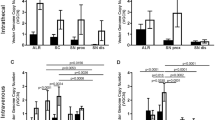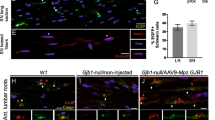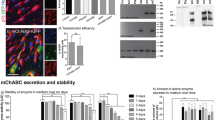Abstract
Schwannomas are peripheral nerve sheath tumors associated with three genetically distinct disease entities, namely sporadic schwannoma, neurofibromatosis type-2, and schwannomatosis. Schwannomas are associated with severe disability and in cases lead to death. The primary treatment is operative resection that itself can cause neurologic damage and is at times contra-indicated due to tumor location. Given their homogenous Schwann-lineage cellular composition, schwannomas are appealing targets for gene therapy. In the present study, we have generated an adeno-associated serotype 1 virus (AAV1)-based vector delivering N-terminal of the pyroptotic gene Gasdermin-D; (GSDMDNterm) under the control of the Schwann-cell specific promoter, P0. we have demonstrated that AAV1-P0-GSDMDNterm injection into intra-sciatic schwannomas reduces the growth of these tumors and resolves tumor-associated pain without causing neurologic damage. This AAV1-P0-GSDMDNterm vector holds promise for clinical treatment of schwannomas via direct intra-tumoral injection.
This is a preview of subscription content, access via your institution
Access options
Subscribe to this journal
Receive 12 print issues and online access
$259.00 per year
only $21.58 per issue
Buy this article
- Purchase on Springer Link
- Instant access to full article PDF
Prices may be subject to local taxes which are calculated during checkout





Similar content being viewed by others
Change history
06 May 2019
The original version of this Article contained an error in the spelling of the author Ahmed Abdelanabi, which was incorrectly given as Abdelanabi Ahmed. This has now been corrected in both the PDF and HTML versions of the Article.
References
Evans DG. Neurofibromatosis type 2 (NF2): a clinical and molecular review. Orphanet J Rare Dis. 2009;4:16.
Antinheimo J, Sankila R, Carpen O, Pukkala E, Sainio M, Jaaskelainen J. Population-based analysis of sporadic and type 2 neurofibromatosis-associated meningiomas and schwannomas. Neurology. 2000;54:71–6.
Lu-Emerson C, Plotkin SR. The neurofibromatoses. Part 2: NF2 and schwannomatosis. Rev Neurol Dis. 2009;6:E81–6.
Carlson ML, Jacob JT, Habermann EB, Glasgow AE, Raghunathan A, Link MJ. Malignant peripheral nerve sheath tumors of the eighth cranial nerve arising without prior irradiation. J Neurosurg. 2016;125:1120–9.
Yamanaka R, Hayano A. Radiation-induced malignant peripheral nerve sheath tumors: a systematic review. World Neurosurg. 2017;105:961–70 e8.
Wong HK, Lahdenranta J, Kamoun WS, Chan AW, McClatchey AI, Plotkin SR, et al. Anti-vascular endothelial growth factor therapies as a novel therapeutic approach to treating neurofibromatosis-related tumors. Cancer Res. 2010;70:3483–93.
Prabhakar S, Brenner GJ, Sung B, Messerli SM, Mao J, Sena-Esteves M, et al. Imaging and therapy of experimental schwannomas using HSV amplicon vector-encoding apoptotic protein under Schwann cell promoter. Cancer Gene Ther. 2010;17:266–74.
Prabhakar S, Taherian M, Gianni D, Conlon TJ, Fulci G, Brockmann J, et al. Regression of schwannomas induced by adeno-associated virus-mediated delivery of caspase-1. Hum Gene Ther. 2013;24:152–62.
He WT, Wan H, Hu L, Chen P, Wang X, Huang Z, et al. Gasdermin D is an executor of pyroptosis and required for interleukin-1beta secretion. Cell Res. 2015;25:1285–98.
Kayagaki N, Stowe IB, Lee BL, O'Rourke K, Anderson K, Warming S, et al. Caspase-11 cleaves gasdermin D for non-canonical inflammasome signalling. Nature. 2015;526:666–71.
Shi J, Zhao Y, Wang K, Shi X, Wang Y, Huang H, et al. Cleavage of GSDMD by inflammatory caspases determines pyroptotic cell death. Nature. 2015;526:660–5.
Lamkanfi M. Emerging inflammasome effector mechanisms. Nat Rev Immunol. 2011;11:213–20.
Broz P. Immunology: caspase target drives pyroptosis. Nature. 2015;526:642–3.
Hung G, Li X, Faudoa R, Xeu Z, Kluwe L, Rhim JS, et al. Establishment and characterization of a schwannoma cell line from a patient with neurofibromatosis 2. Int J Oncol. 2002;20:475–82.
Lepont P, Stickney JT, Foster LA, Meng JJ, Hennigan RF, Ip W. Point mutation in the NF2 gene of HEI-193 human schwannoma cells results in the expression of a merlin isoform with attenuated growth suppressive activity. Mutat Res. 2008;637:142–51.
Tanaka K, Eskin A, Chareyre F, Jessen WJ, Manent J, Niwa-Kawakita M, et al. Therapeutic potential of HSP90 inhibition for neurofibromatosis type 2. Clin Cancer Res. 2013;19:3856–70.
Wray S, Self M, Consortium NPsDi, Consortium NPsDi, Consortium NAi, Lewis PA, et al. Creation of an open-access, mutation-defined fibroblast resource for neurological disease research. PLoS ONE 2012;7:e43099.
Brown AM, Lemke G. Multiple regulatory elements control transcription of the peripheral myelin protein zero gene. J Biol Chem. 1997;272:28939–47.
McCarty DM, Fu H, Monahan PE, Toulson CE, Naik P, Samulski RJ. Adeno-associated virus terminal repeat (TR) mutant generates self-complementary vectors to overcome the rate-limiting step to transduction in vivo. Gene Ther. 2003;10:2112–8.
Broekman ML, Comer LA, Hyman BT, Sena-Esteves M. Adeno-associated virus vectors serotyped with AAV8 capsid are more efficient than AAV-1 or -2 serotypes for widespread gene delivery to the neonatal mouse brain. Neuroscience. 2006;138:501–10.
Saydam O, Ozdener GB, Senol O, Mizrak A, Prabhakar S, Stemmer-Rachamimov AO, et al. A novel imaging-compatible sciatic nerve schwannoma model. J Neurosci Methods. 2011;195:75–7.
Agarwal N, Pacher P, Tegeder I, Amaya F, Constantin CE, Brenner GJ, et al. Cannabinoids mediate analgesia largely via peripheral type 1 cannabinoid receptors in nociceptors. Nat Neurosci. 2007;10:870–9.
Kirschbaum KM, Hiemke C, Schmitt U. Rotarod impairment: catalepsy-like screening test for antipsychotic side effects. Int J Neurosci. 2009;119:1509–22.
Chen Q, Peto CA, Shelton GD, Mizisin A, Sawchenko PE, Schubert D. Loss of modifier of cell adhesion reveals a pathway leading to axonal degeneration. J Neurosci. 2009;29:118–30.
Hargreaves K, Dubner R, Brown F, Flores C, Joris J. A new and sensitive method for measuring thermal nociception in cutaneous hyperalgesia. Pain. 1988;32:77–88.
Messerli SM, Tang Y, Giovannini M, Bronson R, Weissleder R, Breakefield XO. Detection of spontaneous schwannomas by MRI in a transgenic murine model of neurofibromatosis type 2. Neoplasia. 2002;4:501–9.
Harris JE, Sheean PM, Gleason PM, Bruemmer B, Boushey C. Publishing nutrition research: a review of multivariate techniques--part 2: analysis of variance. J Acad Nutr Diet. 2012;112:90–8.
Sborgi L, Ruhl S, Mulvihill E, Pipercevic J, Heilig R, Stahlberg H, et al. GSDMD membrane pore formation constitutes the mechanism of pyroptotic cell death. EMBO J. 2016;35:1766–78.
Prabhakar S, Messerli SM, Stemmer-Rachamimov AO, Liu TC, Rabkin S, Martuza R, et al. Treatment of implantable NF2 schwannoma tumor models with oncolytic herpes simplex virus G47Delta. Cancer Gene Ther. 2007;14:460–7.
Acknowledgements
We thank Dr. Marco Giovannini, M.D., Ph.D. (UCLA Health) for the HEI-193 and 08031-9 cell lines, and Timothy Houle, Ph.D. (Department of Anesthesia, Critical Care and Pain Medicine, MGH) for his assistance with statistical analysis.
Funding
This work was supported by NIH/NINDS R01 NS081146, NIH/NINDS tR21 NS088013, and a charitable donation from Neurofibromatosis Northeast to the Rebecca Grasso Fund.
Author information
Authors and Affiliations
Corresponding author
Ethics declarations
Conflict of interest
The authors declare that they have no conflict of interest.
Additional information
Publisher’s note: Springer Nature remains neutral with regard to jurisdictional claims in published maps and institutional affiliations.
Supplementary information
Rights and permissions
About this article
Cite this article
Ahmed, S.G., Abdelanabi, A., Doha, M. et al. Schwannoma gene therapy by adeno-associated virus delivery of the pore-forming protein Gasdermin-D. Cancer Gene Ther 26, 259–267 (2019). https://doi.org/10.1038/s41417-018-0077-3
Received:
Revised:
Accepted:
Published:
Issue Date:
DOI: https://doi.org/10.1038/s41417-018-0077-3
This article is cited by
-
Targeting cell death pathways for cancer therapy: recent developments in necroptosis, pyroptosis, ferroptosis, and cuproptosis research
Journal of Hematology & Oncology (2022)
-
AAV9-mediated Schwann cell-targeted gene therapy rescues a model of demyelinating neuropathy
Gene Therapy (2021)
-
Strategies to package recombinant Adeno-Associated Virus expressing the N-terminal gasdermin domain for tumor treatment
Nature Communications (2021)
-
Efficacy of AAV serotypes to target Schwann cells after intrathecal and intravenous delivery
Scientific Reports (2021)



